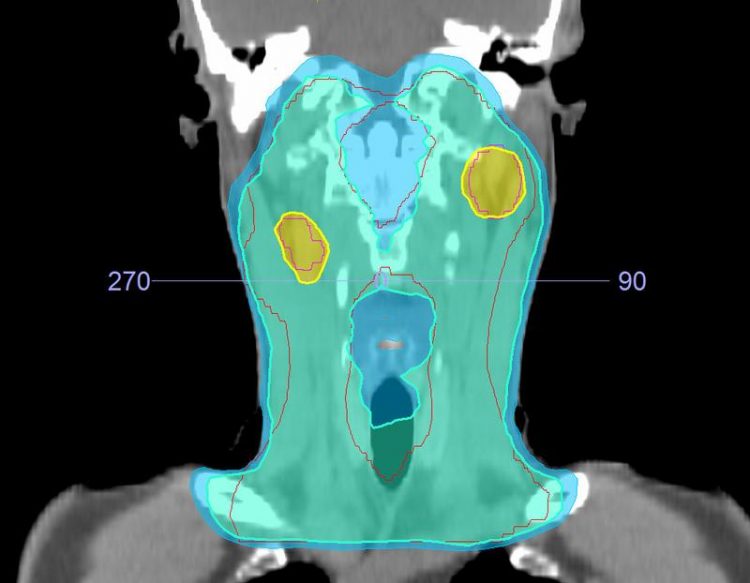BMBF funds translational project to improve radiotherapy

Irradiation planning of a head-neck tumor Source: Klinikum der Universität München
The term ‘head-neck cancer’ is used to refer to various tumor types that occur in this part of the body, for example, cancer of the oral cavity or pharynx. Radiotherapy, either alone or combined with surgery and/or chemotherapy, is a central element in the complex treatment strategies.
Difficulties arise, however, if the tumors demonstrate so-called radiation resistance and do not respond to the treatment as desired, or if undesirable effects occur that make it necessary to stop the treatment.
“This is where the ZiSStrans project comes in,” explains coordinator Prof. Dr. Horst Zitzelsberger, head of the Radiation Cytogenetics Research Unit at the Helmholtz Zentrum München. “Our objective is to identify molecular signaling pathways and target structures for the radiation response and to examine them in patient studies.”
In this field, this step is called translation, which also explains the project's name. Because ZiSStrans is the translational follow-up project of “Targets and signaling pathways of radiation hypersensitivity and resistance” or ZiSS for short, which ran from 2012 to 2017.
http://www.bfs.de/EN/bfs/science-research/third-party-funded-research/ziss.html;…
The researchers particularly hope to gain new insights by comparing tumor and normal tissue. “The radiosensitivity of the surrounding healthy tissue limits the radiotherapy intensity which can be applied, because this is where undesirable effects can occur,” Zitzelsberger explains.
By understanding the signaling networks in the tumor and normal tissue, the researchers want to explore how the radiation response and resistance can be selectively influenced and how the treatment success can be improved by molecular substances.
A further focus of the research consortium is on personalized treatment. The use of new markers should make it possible to predict whether or not the particular patient will be able to profit from the planned action, even before the first radiation treatment. “In the future, we want to be able to say with great certainty that a particular patient is either a ‘responder’ or a ‘non-responder’, which means if the patient will respond to the treatment or if other options must be considered in advance,” says coordinator Zitzelsberger.
Of the total of four million euros that the BMBF will be providing to the project between 2017 and 2022, around 800,000 will be allocated to the Helmholtz Zentrum München. In addition to Research Unit Head Zitzelsberger, the groups of Dr. Julia Heß and Dr. Kristian Unger are also involved. Furthermore, the following partners are participating in the project:
• University Hospital of Munich (LMU, Department for Radiotherapy and Radiation Oncology, Prof. Lauber, Prof. Belka)
• Essen University Hospital (Institute of Cell Biology, Prof. Jendrossek, PD Dr. Klein)
• Medical Center – University of Freiburg (Center for Diagnostic and Therapeutic Radiology, Prof. Henke)
• Charité University Hospital Berlin (Institute of Pathology, Prof. Blüthgen)
• German Federal Office for Radiation Protection Neuherberg (Biological Radiation Effects, Dr. Hornhardt, Dr. Gomolka)
• Clinical cooperation group “Personalized radiotherapy of head-neck tumors” involving the Department for Radiotherapy and Radiation Oncology, University Hospital of Munich (LMU) and the Radiation Cytogenetics Research Unit, Helmholtz Zentrum München
Further information
Background:
Almost one year ago, researchers in the consortium had already developed a new method of predicting disease progression of certain brain tumors after standard treatment. In the journal ‘Oncotarget’, they were able to show that four miRNAs can provide the crucial indications. A direct application for a corresponding patent has already been made: https://www.helmholtz-muenchen.de/en/press-media/press-releases/all-press-releas…
In the thyroid gland, the researchers have also been able to identify markers for tumors induced by radiation: https://www.helmholtz-muenchen.de/en/press-media/press-releases/all-press-releas…
The Helmholtz Zentrum München, the German Research Center for Environmental Health, pursues the goal of developing personalized medical approaches for the prevention and therapy of major common diseases such as diabetes and lung diseases. To achieve this, it investigates the interaction of genetics, environmental factors and lifestyle. The Helmholtz Zentrum München is headquartered in Neuherberg in the north of Munich and has about 2,300 staff members. It is a member of the Helmholtz Association, a community of 18 scientific-technical and medical-biological research centers with a total of about 37,000 staff members. http://www.helmholtz-muenchen.de/en
The Research Unit Radiation Cytogenetics (ZYTO) investigates radiation-induced chromosome and DNA damage in cell systems and human tumours. The focus is on clarifying the mechanisms associated with radiation-induced carcinogenesis and radiation sensitivity of tumour cells. The aim of this research is to find biomarkers associated with radiation-induced tumours in order to develop personalized radiation therapy for the stratification of patients. ZYTO is a part of the Department of Radiation Sciences (DRS). http://www.helmholtz-muenchen.de/zyto
Contact for the media:
Department of Communication, Helmholtz Zentrum München – German Research Center for Environmental Health, Ingolstädter Landstr. 1, 85764 Neuherberg – Tel. +49 89 3187 2238 – E-mail: presse@helmholtz-muenchen.de
Scientific Contact at Helmholtz Zentrum München:
Prof. Dr. Horst Zitzelsberger, Helmholtz Zentrum München – German Research Center for Environmental Health, Research Unit Radiation Cytogenetics, Ingolstädter Landstr. 1, 85764 Neuherberg – Tel. +49 89 3187 3421, E-mail: Zitzelsberger@helmholtz-muenchen.de
Media Contact
All latest news from the category: Awards Funding
Newest articles

A ‘language’ for ML models to predict nanopore properties
A large number of 2D materials like graphene can have nanopores – small holes formed by missing atoms through which foreign substances can pass. The properties of these nanopores dictate many…

Clinically validated, wearable ultrasound patch
… for continuous blood pressure monitoring. A team of researchers at the University of California San Diego has developed a new and improved wearable ultrasound patch for continuous and noninvasive…

A new puzzle piece for string theory research
Dr. Ksenia Fedosova from the Cluster of Excellence Mathematics Münster, along with an international research team, has proven a conjecture in string theory that physicists had proposed regarding certain equations….



